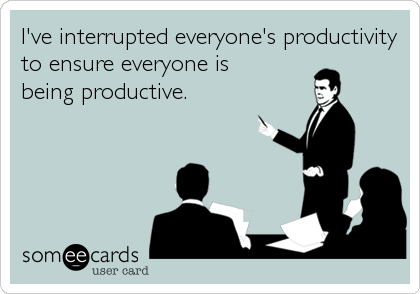 Sounds about right Sounds about right To be productive one has to first produce and secondly to produce productively. Productivity is rather simple and in the pursuit of enhancing productivity perhaps therein lies the key to success – keeping things simple. What are we producing and are we producing it efficiently? It may not be that surprising to discover than many companies are not that clear on what their core offering is. In the business world there are goods and there are services and there are companies that do both, but those two components are the primary mode of value for any entity in the marketplace. Those organizations that know what their value offering is and how to position that value are the companies that have the best opportunity (nothing is guaranteed) to operate as a viable business. The primary obstacle for any individual who seeks to start a business is to make the decision to go for it. Put another way, the primary step in starting is simply starting. When a person has identified a good or service that they can bring to the marketplace with value, they must first overcome their own fear of failure (atychiphobia). This applies to starting anything, whether it’s a new business, a new direction or a new discipline within an existing organization. Productivity requires vision. “There are risks and costs to action. But they are far less than the long range risks of comfortable inaction.” – John F. Kennedy, former U.S. President Everything has a consequence, those who are looking to start something or make a change need to find the confidence to move forward with what their vision and values are telling them to do. Having vision is of great value, when an individual sees a need for change the next step is to put some thought, action and endurance into motion to see that thing through. Productivity requires movement. Efficiency is a measure the ability to produce something in relationship to the output of resources utilized. Resources include raw materials, capital and labor. For so many that make the leap to start their own business, they think, “If I was making $20 per hour and now I am making $30 per hour as a business owner, I am really making it.” What they don’t take into account is that they are self-employed and paying themselves $30 an hour but if that is also all they are charging then they are setting nothing aside for overhead costs such as vehicle maintenance, office supplies, utilities, taxes and etc. Productivity requires data. “If your business depends on you, you don't own a business-you have a job. And it's the worst job in the world because you're working for a lunatic...You can't close it when you want to, because if it's closed you don't get paid. You can't leave it when you want to, because if you leave there's nobody there to do the work. You can't sell it when you want to, because who wants to buy a job?” —Michael Gerber, author of E-Myth Productivity has to do with being efficient with your resources while providing your product or service. Being able to measure productivity involves knowing your production costs, the adage that the numbers don’t lie is true as long as you track your numbers accurately and allow them to speak for themselves without manipulation. If you seek to be productive the first steps involve finding a means to track your costs such as labor, materials, overhead costs and profitability goals. Productivity requires listening. (Video on listening HERE) While the point of this article is not to be a deep expose into the intricacies of cost analysis in relationship to productivity goals, it is important to note that they only way to track productivity is first to be tracking something. A simple excel spreadsheet can assist to track time and materials applied to a project. Start by tracking expenditures and revenue daily and where there are spikes in either dig into where those inconsistencies are coming from. Allow the numbers to show you what is and what isn’t working, or to at least understand the expenditure of resources going into pursuing your vision. Productivity requires tracking. “I never lie because I don’t fear anyone. You only lie when you’re afraid.” – John Gotti, crime boss Failure to launch is rooted in the fear of failure. We stop ourselves short of putting our vision into motion because we undervalue our ability to create value, rise above obstacles and adapt as we receive new information along the way. Failure to improve is rooted in the same fear of failure (more HERE). Often we deceive ourselves into thinking things are working because of tradition, ie this is how things have always been done and so it’s safe to continue swimming with the stream, or because of blind commitment to a system of productivity that has handed down to us, where there is less resistance by simply keeping with the plan rather than challenging the machine. Productivity requires honesty. “We cannot solve our problems with the same thinking we used when we created them.” – Albert Einstein They say the definition of insanity is doing the same thing but expecting different results, yet the status quo is doing the same thing expecting the same results. The market is constantly changing and the pace of change is running at a rate that is leaving those who are not adapting in the dust. When we don’t ask the hard questions, such as is this working, is this sustainable and is there a better way, then we cut ourselves short of unlocking productivity improvements. Productivity requires adaptation. Productivity can seem complex, but at the core it is rather simple. Stay clear about what it is that you are producing, a good or service, and whether you are doing so efficiently. Keeping things simple is a key to being productive. Having a clear vision is the foundation, operating on your values is essential to keeping your identity intact, challenging your fears is a daily test and tracking your numbers is a key discipline. The numbers are simple, they don’t lie but they can be silenced.
0 Comments
|
AuthorThoughts on personal and professional development. Jon Isaacson, The Intentional Restorer, is a contractor, author, and host of The DYOJO Podcast. The goal of The DYOJO is to help growth-minded restoration professionals shorten their DANG learning curve for personal and professional development. You can watch The DYOJO Podcast on YouTube on Thursdays or listen on your favorite podcast platform.
Archives
March 2023
Categories
All
<script type="text/javascript" src="//downloads.mailchimp.com/js/signup-forms/popup/unique-methods/embed.js" data-dojo-config="usePlainJson: true, isDebug: false"></script><script type="text/javascript">window.dojoRequire(["mojo/signup-forms/Loader"], function(L) { L.start({"baseUrl":"mc.us5.list-manage.com","uuid":"b9016446bd3c6a9f0bd835d4e","lid":"83282ffb9e","uniqueMethods":true}) })</script>
|
Jon Isaacson |
Connect. Collaborate. Conquer.
© COPYRIGHT 2015. ALL RIGHTS RESERVED.
|



 RSS Feed
RSS Feed